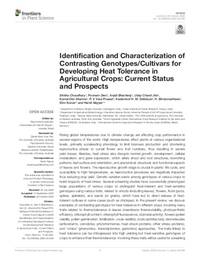Identification and Characterization of Contrasting Genotypes/Cultivars for Developing Heat Tolerance in Agricultural Crops: Current Status and Prospects

Authors:
Rising global temperatures due to climate change are affecting crop performance in several regions of the world. High temperatures affect plants at various organizational levels, primarily accelerating phenology to limit biomass production and shortening reproductive phase to curtail flower and fruit numbers, thus resulting in severe yield losses. Besides, heat stress also disrupts normal growth, development, cellular metabolism, and gene expression, which alters shoot and root structures, branching patterns, leaf surface and orientation, and anatomical, structural, and functional aspects of leaves and flowers. The reproductive growth stage is crucial in plants’ life cycle, and susceptible to high temperatures, as reproductive processes are negatively impacted thus reducing crop yield. Genetic variation exists among genotypes of various crops to resist impacts of heat stress. Several screening studies have successfully phenotyped large populations of various crops to distinguish heat-tolerant and heat-sensitive genotypes using various traits, related to shoots (including leaves), flowers, fruits (pods, spikes, spikelets), and seeds (or grains), which have led to direct release of heat-tolerant cultivars in some cases (such as chickpea). In the present review, we discuss examples of contrasting genotypes for heat tolerance in different crops, involving many traits related to thermotolerance in leaves (membrane thermostability, photosynthetic efficiency, chlorophyll content, chlorophyll fluorescence, stomatal activity), flowers (pollen viability, pollen germination, fertilization, ovule viability), roots (architecture), biomolecules (antioxidants, osmolytes, phytohormones, heat-shock proteins, other stress proteins), and “omics” (phenomics, transcriptomics, genomics) approaches. The traits linked to heat tolerance can be introgressed into high yielding but heat-sensitive genotypes of crops to enhance their thermotolerance. Involving these traits will be useful for screening contrasting genotypes and would pave the way for characterizing the underlying molecular mechanisms, which could be valuable for engineering plants with enhanced thermotolerance. Wherever possible, we discussed breeding and biotechnological approaches for using these traits to develop heat-tolerant genotypes of various food crops.
